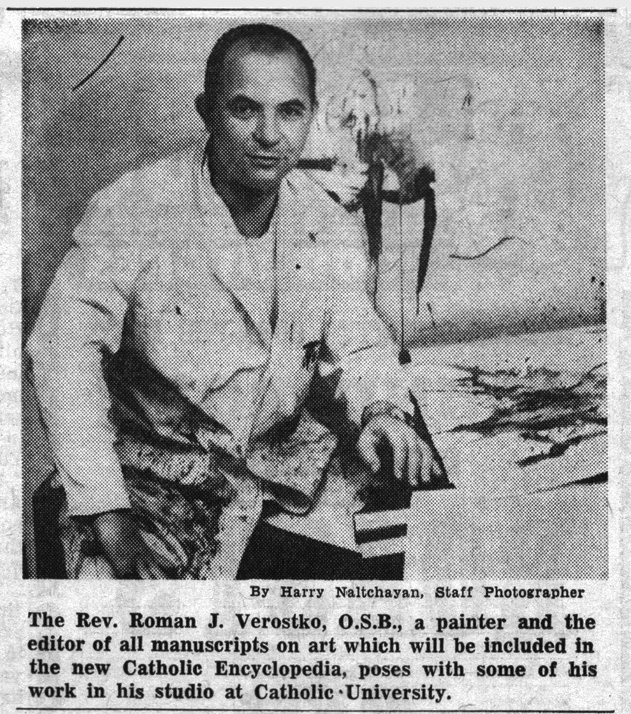
<< Archive Menu | Main Menu | Search | Contact
This review of Roman's work appeared in the Washington Post during his Washington, DC period. Roman had his editorial office at St. John's Hall with other encyclopedia staff. But he also had a studio located on 7th street where he could work on weekends and holidays.
------------------------------------------------------------------------------------------------------------------------------------
THE WASHINGTON POST Monday, May 24, 1965
A3

Scholarly Priest Is at Home With the Beats
By Geoffrey A. Wolff, Washington Post Staff Writer
There is this New York loft party, just like in the movies: swirling, in-group, shorthand monologues filtered through the beards of beats in motorcycle boots and jackets and aimed at long-haired, net-stockinged, sallow-faced girls.
Into this scene project a balding, stocky, tough-looking coal miner's son in his 30's. It would help to think of him as a welterweight boxer, or, better, as a second-string actor type-cast as the drill sergeant in the kinds of war flicks seemingly made with the Late Show in mind.
Call him Father Roman Verostko, O.S.B.. and color his robes black and give him a clerical collar.
At the loft party they are flipping; they think Father Roman wandered in from a costume party. They are wrong.
Father Roman is as comfortable at the loft parties he attends as he is at his job reading manuscripts for the art chapters of the New Catholic Encyclopedia being compiled at Catholic University. Father Roman is:
- A priest of the Benedictine order
- A scholar and teacher who lives in the seclusion of St. Vincent Monastery in Latrobe, Pa.
- A way-out painter (abstract expressionism) who is obsessed with ambiguity and who lives his obsession as he paints it.
He entered the monastery in 1950 and has studied, taught and painted there since, with the exceptions of the year he spent painting and studying in Paris in 1963, and a year studying at Pratt Institute in Brooklyn and Columbia in Manhattan in 1961.
Now, at 35, he knows what he wants to do , he says, and that is to return to the seclusion of his monastic life and paint and write as soon as his present job is finished this summer.
Well, one shrugs, surely there is nothing strange about that ambition in a priest. But with Father Roman things are not that simple.
There he is, in seclusion, and yet his thoughts and paintings are primarily a function of his experience of the outside world.
He concerns himself with the hats and pants and refuse of the workaday world, feeling, he says, the way things LOOK is the best barometer to indicate the state of a civilization.
The way the owner of a shoe store displays his products in his show windows tells the story Father Roman wants to translate into the expressionism of his painting.
"These celebrate the hope of our living and growing," he said. "The neon-flickers; the billboard leaps in landscape; telephone-booth markings reveal us . . . "
Father Roman answers questions very precisely and after long consideration, as though words, his words, once having been exposed to the air, travel straight and fast as bullets to their target, as though there is no calling them back or deflecting their path.
Yet the precision of the man's language contrasts to his appearance and movements: clothes seem to encumber him; he seems to rebel against that restraint by smearing walls with the gaudy colored sketches of his artistic thoughts.
The room, then, in a quiet house occupied by sedate sisters and priests, serves as a notebook for Father Roman. A sign on the door says PRIVATE (and means it) and the paintings themselves, done on wood, are visual paradigms of the painter's programmed ambiguity.
Against wild undisciplined brush-strokes he imposes perfectly sculptured geometric shapes.
"My paintings are spontaneous emotion; they are also calculated precision; they search to resolve oppositions in a visual dialogue; they are born from the belief that we are growing to a great love that will resolve the ambiguous and deliver us to Peace."
There, then is the first hint of resolution in the ambiguities presented by Father Roman. The bridge of faith that enables him to cross from neon flickers to self-imposed solitary confinement and to record that crossing with paint, a wild heart and a firm hand.
_________________________________